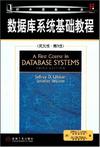数据库系统基础教程
出版时间:2008-8 出版社:机械工业出版社 作者:厄尔曼 (Jeffrey D. Ullman);怀德姆 (Jennifer Widom) 页数:565
Tag标签:无
内容概要
本书由美国斯坦福大学知名计算机科学家Jeffrey Ullman和Jennifer Widom合作编写。书中介绍了核心DBMS概念、理论和模型,描述了如何使用抽象语言和SQL查询与更新DBMS。在介绍了SQL扩展内容(包括嵌入式SQL程序设计和对象关系特征)后,又介绍了使用XML的系统。设计语言包括XML模式,查询语言包括XPath和XQuery。
作者简介
Jeffrey D.UIIman斯坦福大学计算机科学系.Stanford W.Ascherman教授,数据库技术专家。他独立或与人合作出版了15本著作,发表了170多篇技术论文。他的研究兴趣包括数据库理论.数据库集成、数据挖掘和利用信息基础设施进行教育。他是美国国家工程院成员,曾获得Knuth
书籍目录
1 The Worlds of Database Systems 1.1 The Evolution of Database Systems 1.1.1 Early Database Management Systems 1.1.2 Relational Database Systems 1.1.3 Smaller and Smaller Systems 1.1.4 Bigger and Bigger Systems 1.1.5 Information Integration 1.2 Overview of a Database Management System 1.2.1 Data-Definition Language Commands 1.2.2 Overview of Query Processing 1.2.3 Storage and Buffer Management 1.2.4 Transaction Processing 1.2.5 The Query Processor 1.3 Outline of Database-System Studies 1.4 References for Chapter 1Ⅰ Relational Database Modeling2 The Relational Model of Data 2.1 An Overview of Data Models 2.1.1 What is a Data Model? 2.1.2 Important Data Models 2.1.3 The Relational Model in Brief 2.1.4 The Semistructured Model in Brief 2.1.5 Other Data Models 2.1.6 Comparison of Modeling Approaches 2.2 Basics of the Relational Model 2.2.1 Attributes 2.2.2 Schemas 2.2.3 Tuples 2.2.4 Domains 2.2.5 Equivalent Representations of a Relation 2.2.6 Relation Instances 2.2.7 Keys of Relations 2.2.8 An Example Database Schema 2.2.9 Exercises for Section 2.2 2.3 Defining a Relation Schema in SQL 2.3.1 Relations in SQL 2.3.2 Data Types 2.3.3 Simple Table Declarations 2.3.4 Modifying Relation Schemas 2.3.5 Default Values 2.3.6 Declaring Keys 2.3.7 Exercises for Section 2.3 2.4 An Algebraic Query Language 2.4.1 Why Do We Need a Special Query Language? 2.4.2 What is an Algebra? 2.4.3 Overview of Relational Algeebra 2.4.4 Set Operations on Relations 2.4.5 Projection 2.4.6 Selection 2.4.7 Cartesian Product 2.4.8 Natural Joins 2.4.9 Theta-Joins 2.4.10 Combining Operations to Form Queries 2.4.11 Naming and Renaming 2.4.12 Relationships Among Operations 2.4.13 A Linear Notation for Algebraic Expressions 2.4.14 Exercises for Section 2.4 2.5 Constraints on Relations 2.5.1 Relational Algebra as a Constraint Language 2.5.2 Referential Integrity Constraints 2.5.3 Key Constraints 2.5.4 Additional Constraint Examples 2.5.5 Exercises for Secticn 2.5 2.6 Summary of Chapter 2 2.7 References for Chapter 23 Design Theory for Relational Databases 3.1 Functional Dependencies 3.1.1 Definition of Functional Dependency 3.1.2 Keys of Relations 3.1.3 Superkeys 3.1.4 Exercises for Section 3.1 3.2 Rules About Functional Dependencies 3.2.1 Reasoning About Functional Dependencies 3.2.2 The Splitting/Combining Rule ……4 High-Level Database Models5 Algebraic and Logical Query Languages6 The Database Language SQL7 Constraints and Triggers8 Views and Indexes9 SQL in a Server Environment10 Advanced Topics in Relational Databases11 The Semistructured-Data Model12 Programming Languages for XMLIndex
章节摘录
4.6.3Using Null Values to Combine RelationsThere is one more approach to representing information ab out a hier ar chy ofentity sets.If we axe allowed to use NULL(the null value aS in SQL)as avalue in t uples,we can h andle a hier archy of entity sets with a single relationThis relation has all the att rib utes b elonging to any entity set of the hierarchy.An entity is then represented by a single tup le.This tuple has NuLL in eachattribute that is not defined for that entity.Example 4.33:If we applied this approach to the diagram of Fig.4.3 1,wewould create a single relation whose schema iS:Movie(title,year,length,genre,weapon)Those movies t hat are not mur der mysteries would have NULL in the weapon comp onent of their tuple.It would also be necessary to have a relation Voicesto connect those movies that are cartoons to t he starts performing the voices,as in Example.
编辑推荐
《华章图书·数据库系统基础教程(英文版)(第3版)》由机械工业出版社出版。
图书封面
图书标签Tags
无
评论、评分、阅读与下载
用户评论 (总计43条)
- 好书,结构清晰,内容既有深度又能反映目前数据库最新的发展。英文表述好,极易理解!
- 买完后没怎么用到
开心的是数据库系统这门功课及格了,哈哈 - 数据库老师指定教材,书应该还不错,英文不好的童鞋中英文对照着看吧~
- 老师要求的教科书,大二上学期的数据库英文课程,此书不错,喜欢当当的正版
- 对数据库开发很有好处
- 英文版的,写得很容易懂,但是是小本的书,有点厚,不太方便使用
- 看看这个英文版的,感觉中文版的翻译不错。
- 老师推荐使用的教材,写的不错!
- 课程要求,内容有些章节老师还是补充了
- 很经典的一本书。老外的书就是好
- 书的版面很精巧
- 好书 送的快 一直信任当当!
- 读得很畅快,好书!
- 质量蛮好纸质不错
- 对RDBMS的实现有非常深入的讲解。好书一本
- 折扣不错,建议入手。
- If you want to know database system well, just read this book, please!
It's right for the person who is interesting in database theroy.
For someone just want to use database, this book could help you, too.
OK, I have read about one third of it, it's quite great! - 这次发货出了点问题,但还是较好的解决了,希望当当能在客服方面加强点~
- J'aimelelivre~~
- 在国外读书时候用的经典教材!国外的书价太贵了,所以决定在国内买好带出去!
- 质量很好,发货速度也可以
- 学校要求的教材 看不懂 得配合中文翻译啊……
- 就是本人英文太烂,读起来灰常吃力。。。
- 再生纸印的!!!
- 买了三本,两本都蛮好,一本的封面有明显褶皱。。。
- 全英文的,价格很便宜
- 仔细的看了前面几章
里面的句子有的很绕,尤其是在讲3NF,4NF这些概念的时候
后面的内容好像有点少,偏重基础知识 - 质量稍稍有点差,但是送货速度很快,比买英文原版的还是划算很多。
- 一本不错的好书,语言轻松,表达清晰,不愧是经典……
- 知识非常全面,语言也十分通俗易懂,E文过关的同学们可以考虑
- 全英文的教程,不仅可以练习练习英文,还能用外国人的方法来学知识,看外国的教材与我们教材的不同,最好不要看中文的,中文看着始终感觉别扭
- 非常值得购买,还没读完
- 书的语言比较简单,易读。
- 本书浅显易懂,不过首先是建立在你看得懂英文的基础上
- 课程教材,很合适的大小,便于携带,理论很清晰平实
- 估计要弄个中文翻译对照着看。
- 在这个影印版都是16开的年代,32开的书是多么的方便啊!书的质量也很好。
- 速度很快,质量也很好,纸质稍微有点硬~
- 数据库基础的经典教材。英文原版。好书。就是字有点小。
- 我买了两本数据库的书,另一本是database system implementation,印刷质量完全不是一个概念,这本一看就是盗版,卓越也太坑爹了,竟然卖盗版书!!!!
- 商品不错,但是快递的服务态度是这么多次交易中最差的一次,而且速度也比以前慢了两天,书的质量还是很好的。。好评吧
- 斯坦福的教学计划和内容却是很有利于人才培养!
- 机械工业的正版影印图书,字有点小,不过总体感激不错,送货速度快,卓越的服务态度真是好,牛逼,快递也不错.
